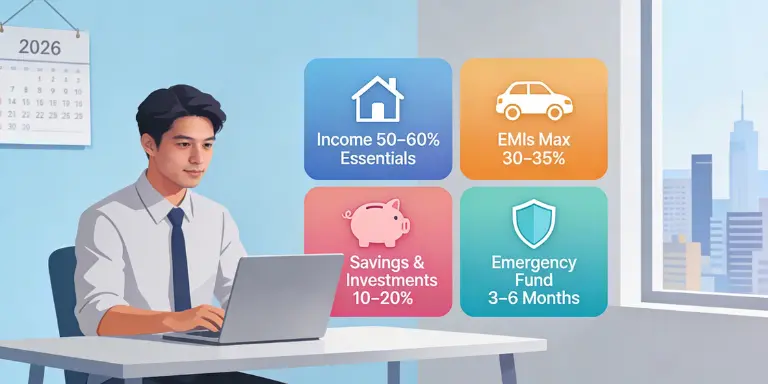Raj Sharma, a 32-year-old software engineer from Pune, achieved what many Indian homeowners dream of—cutting his home loan interest by ₹8,40,000 through strategic prepayments. His journey offers practical lessons for anyone looking to reduce their loan burden home loan prepayment case study.
Raj’s Starting Position: A Typical Home Loan Story
In January 2020, Raj took a ₹75 lakh home loan from HDFC Bank at 8.35% interest for 25 years to buy a 3BHK apartment in Wakad, Pune. Like most borrowers, he was focused on managing his monthly EMI of ₹59,028 rather than the total interest burden.
Initial Loan Details:
- Loan Amount: ₹75,00,000
- Interest Rate: 8.35% p.a.
- Tenure: 25 years (300 EMIs)
- Monthly EMI: ₹59,028
- Total Interest Payable: ₹1,02,08,400
- Total Amount: ₹1,77,08,400
Raj’s wake-up call came when he calculated that he would pay over ₹1 crore in interest alone—more than the loan amount itself.
The Turning Point: Understanding Loan Mechanics
In March 2021, during the pandemic, Raj used his work-from-home time to understand how home loans actually work. He discovered that in the initial years, most of his EMI was going toward interest, not principal reduction.
Year 1 Breakdown (2020):
- Total EMIs Paid: ₹7,08,336 (12 months)
- Principal Repaid: ₹2,46,892
- Interest Paid: ₹4,61,444
“I was shocked to realize that only 35% of my EMI was reducing the actual loan amount,” says Raj.
Strategy 1: Annual Bonus Prepayments
Raj’s first strategy was simple use his annual bonus for loan prepayment instead of discretionary spending.
March 2021 – First Prepayment:
- Prepayment Amount: ₹4,50,000 (annual bonus)
- Outstanding Balance Before: ₹72,53,108
- Outstanding Balance After: ₹68,03,108
- Impact: Reduced tenure by 18 months
This single prepayment would save him approximately ₹2,85,000 in interest over the remaining loan tenure.
Strategy 2: Systematic Step-Up EMIs
In April 2021, Raj implemented a 10% annual EMI increase strategy. Instead of spending salary increments, he channelled them into higher EMIs.
EMI Evolution:
- 2021: ₹59,028 → ₹64,931 (10% increase)
- 2022: ₹64,931 → ₹71,424 (10% increase)
- 2023: ₹71,424 → ₹78,566 (10% increase)
This gradual increase didn’t strain his budget since his income was also growing by 12-15% annually.
Strategy 3: Windfall Prepayments
Raj made additional prepayments whenever he received unexpected money:
- February 2022: ₹2,25,000 from stock investments
- September 2022: ₹1,80,000 from matured fixed deposits
- March 2023: ₹3,15,000 from annual bonus
Each prepayment was made in the early years, when the interest component was highest, thereby maximising savings.
The Numbers: Actual Savings Achieved
By December 2023, Raj had transformed his loan profile dramatically:
Original Scenario (Without Prepayment):
- Total Interest: ₹1,02,08,400
- Loan Closure: January 2045
Actual Scenario (With Prepayments):
- Total Interest Paid: ₹61,68,400
- Interest Saved: ₹8,40,000
- New Closure Date: March 2031
- Tenure Reduced: 14 years
Monthly Cash Flow Impact
Raj’s smart prepayment strategy also improved his monthly cash flow over time:
| Year | Original EMI | Actual EMI | Outstanding Balance | Monthly Interest Saved |
|---|---|---|---|---|
| 2020 | ₹59,028 | ₹59,028 | ₹75,00,000 | ₹0 |
| 2021 | ₹59,028 | ₹64,931 | ₹63,53,108 | ₹812 |
| 2022 | ₹59,028 | ₹71,424 | ₹49,48,108 | ₹1,247 |
| 2023 | ₹59,028 | ₹78,566 | ₹32,13,108 | ₹1,842 |
Key Implementation Lessons
Timing Matters Most
Raj’s success came from making prepayments in the first 3-4 years when interest constituted 75-80% of his EMI.
“Every rupee prepaid in year 2 saved me ₹3-4 in total interest,” he explains.
Automation Prevented Temptation
Raj set up automatic transfers from his salary account to a dedicated “prepayment fund” to avoid spending the money elsewhere.
Emergency Fund Protection
Throughout his prepayment journey, Raj maintained an emergency fund equal to 8 months of expenses, ensuring prepayments didn’t compromise his financial security.
Common Mistakes Raj Avoided
1. Prepayment Penalty Trap:Raj confirmed that HDFC Bank had no prepayment charges for floating-rate loans before starting.
2. Tax Benefit Loss:
He calculated that prepayment savings (8.35% guaranteed) exceeded tax benefits under the old regime.
3. Opportunity Cost Miscalculation:
Rather than chasing 10-12% market returns, Raj chose the guaranteed 8.35% savings from prepayment.
The Psychological Benefits
Beyond financial savings, Raj experienced significant peace of mind:
- Reduced Debt Stress: Lower outstanding balance meant less financial anxiety
- Increased Investment Capacity: Earlier loan closure freed up ₹78,566 monthly for other goals
- Improved Credit Profile: Consistent prepayments boosted his credit score to 805
Replicating Raj’s Success: Action Steps
Step 1: Calculate Your Savings PotentialUse an online prepayment calculator to determine how much you can save based on your loan details.
Step 2: Start SmallBegin with your next bonus or tax refund, even if it’s just ₹50,000-₹1,00,000.
Step 3: Automate the ProcessSet up systematic prepayments aligned with your salary increments.
Step 4: Track Progress
Monitor your outstanding balance quarterly to stay motivated.
When Prepayment Might Not Work
Raj’s strategy worked because:
- His loan interest rate (8.35%) was higher than safe investment returns
- He had stable income with regular increments
- No other high-interest debt (credit cards, personal loans)
- Strong emergency fund in place
Prepayment might not be optimal if you have higher-interest debt or can consistently earn 10%+ returns in equity markets.
Key Takeaways
- Early prepayments provide maximum impact when interest component is highest
- Systematic approach beats sporadic large payments for sustainable debt reduction
- Guaranteed 8-9% savings from prepayment often beats risky market investments
- Maintain emergency fund while pursuing aggressive prepayment
- Use windfalls strategically rather than lifestyle inflation
- Track progress regularly to maintain motivation
- Consider opportunity costs but don’t ignore peace of mind benefits
Raj’s disciplined approach turned a 25-year debt burden into 11 years of payments, saving ₹8,40,000 in interest. His success proves that with the right strategy and consistent execution, significant loan savings are achievable for middle-class Indian families.
The key is starting early, staying consistent, and prioritizing guaranteed savings over uncertain investment returns.
As Raj puts it, “Every prepayment was like giving myself a risk-free 8.35% return—better than most investment options available.”
Visit More Infoemation : https://emicalculator.vip/blog



